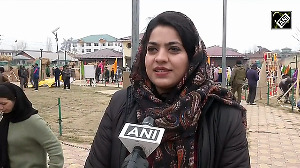The temple was found in the region affected by the December 26 Asian tsunami, and the "discovery now poses very interesting questions about the history of tsunamis," said Thyagarajan Satyamurthy, the archaeologist leading the excavation.
Complete coverage: Tsunami: Waves of destruction
The temple appears to have been built between the second century B.C. and the first century A.D. It was excavated this month just north of Mahabalipuram, a port town 50 kilometers (30 miles) south of Madras, in the southern state of Tamil Nadu, by a team from the government Archaeological Survey of India, Satyamurthy said.
"This is the earliest temple discovered in this region so far," Satyamurthy said.
The archaeologists are trying to determine the date of the tsunami that may have destroyed the temple. They are using sand and seashells found at the brick structure, dedicated to Lord Muruga, a Hindu god, Satyamurthy told the Associated Press.
He said there was more damage on the sea facing side of the temple, and that sand and shells were normally not found so far inland.
Geophysicists at a government laboratory in southern Trivandrum city called them "palaeo-tsunami" deposits, he said.
The temple was found one layer below a granite temple excavated by the same team in July, causing archaeologists to theorize that the Pallava kings, who ruled the region between 580 AD and 728 AD, built the later temple on top of the remains of the older one.
The team also found stucco figurines, terra-cotta lamps, beads and roofing tiles. Similar articles and large bricks were typically used around the beginning of the first millennium, he said.
Mahabalipuram, the capital of an ancient kingdom, is already well known for its intricately carved shore temples that have been declared a world heritage site and are visited each year by thousands of Hindu pilgrims and tourists.
According to descriptions by early British travel writers, the area was also home to seven pagodas, six of which were submerged by the sea.
But just as an ancient tsunami may have ravaged the temple outside Mahabalipuram, last year's Indian Ocean tsunami revealed other temples and monuments that had been buried for centuries.
In February, archaeologists began underwater excavations of what is believed to be an ancient city and parts of a temple uncovered by the waves.
Three rocky structures with elaborate carvings of animals emerged near Mahabalipuram after the waves receded, washing away sand deposits that had covered the structures, which archaeologists have said appear to belong to a port city built in the seventh century.
The ruins of the temple north of Mahabalipuram that Satyamurthy discussed on Wednesday were not uncovered by the recent tsunami, and excavation did not begin until after the waves struck.
But the finding of that temple and the structures uncovered by last year's tsunami has revived a debate over whether references in ancient literature to cities and towns being submerged by violent waves referred to a tsunami.
"We could never study an ancient tsunami without having some man-made materials surviving from that time," Satyamurthy said. "This temple is our link to that."
He said archaeologists have discovered similar deposits of sand and shells at excavations in the town of Poompuhar, another ancient port south of where the latest temple was found. "We didn't know what the deposits meant, because we never studied the possibility of a tsunami," Satyamurthy said. "That angle never occurred to us."
"But after last year's tsunami, we have begun asking ourselves whether this could be evidence of a tsunami," he said.
External Link: Archaeological Survey of India






 © 2025
© 2025